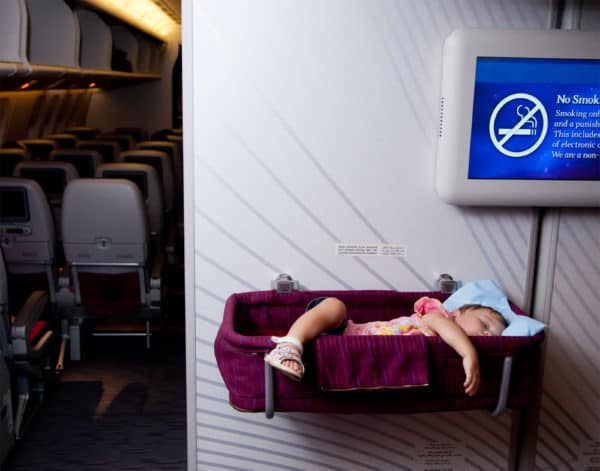

Anxiety about traveling internationally with infants is fairly common. Traveling with babies can be a challenge, but it’s not impossible. Here are some common questions and answers about how to fly with infants.
These days there are a lot of code-shares where you book a ticket with one airline but the flight is operated by a different airline. When you fly with infants, pay attention to the rules of the airline that is operating the flight. Those are the rules that will apply.
Fly with infants – How young is too young?
Babies should not fly until they are one week old. Some doctors discourage long flights with children younger than three months old. That’s partly because the recycled air in the cabin is dry, making it difficult to keep young infants hydrated. The recycled air can also be a problem because young infants have low immunity.
In general, babies and infants will be fine on the flight as long as you keep them hydrated. The change in air pressure during take off and landing can be painful for them. Fluids during that time can help because the swallowing action will help to equalize their ears.
The Transportation Security Administration specifically allows formula, breast milk, and juice for infants or toddlers. There may be additional screening measures to clear you through security, but these items are allowed. You can check the full TSA policy on this here.
How far you’re willing to fly with an infant depends on you. Extremely long flights can be difficult because of changing diapers in cramped airplane bathrooms or the need for a lot of supplies.
Pay for a seat?

Check the airline’s policy on this. Within the United States, infants under the age of two traveling without their own seat within the United States do not require a ticket. Bear in mind that a child without a seat typically does not have a baggage allowance (or carry-on).
All infants traveling internationally must have a ticket, even if no seat is purchased and they are traveling as a lap child. Some airlines require you to pay a fee for a lap child on international flights. On American Airlines, for example, this is 10% of the adult fare, plus taxes and fees.
You may use a child safety seat (car seat) if you have purchased a seat for your child. There are restrictions on which seats can have a car seat. Car seats cannot be used in exit rows or the rows adjacent to exit rows.
Bassinets

Most airlines now have bassinets that can be attached to the bulkhead on international flights. They may not be used during taxi, takeoff or landing, or when the seatbelt sign is illuminated. Request a bassinet by contacting the airline directly.
The number of bassinets per plane is limited and they are on a first come, first served basis, so don’t make this the centerpiece of your plan.
Strollers
On American Airlines, small collapsible strollers up to 20 lbs may be stored in the overhead compartment. United Airlines and Delta require strollers to be checked at the gate. Strollers are not counted against your baggage allowance and airlines do not typically charge to check them.
For more info on traveling with kids, check out my book on the topic.

I’m sorry, but sometimes a parent has no choice but to fly with an infant. My husband is in the military and we have to move across the country. We have no choice, but to fly with our 5 month old because I’m not going to torture my baby with a 5 day drive across the country just for others comfort. When flying you are in close proximity with a lot of people and it won’t always be a pleasant experience. Perhaps you need to prepare yourself to accept that you are in a public space and the world does not revolve around you. Get yourself some noise cancelling head phones or don’t fly at all.
I was frightened with the thought of having to fly with a young baby. However, this post has put me at ease because now I know I don’t have to cancel vacation plans just as long as the baby remains hydrated. I am curious if there are any more airlines with the same policies that you have outlined.